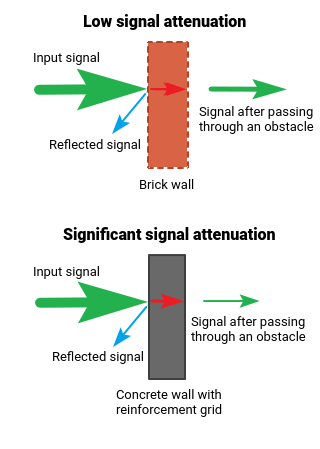Wi-Fi signal attenuation coefficients when passing through different materials
Will Wi-Fi work in the next room across two walls?
For wireless Wi-Fi connection, it is important what obstacle is in the way of signal distribution.
Various obstacles (walls, ceilings, furniture, metal doors, etc.) located between Wi-Fi devices may partially or significantly reflect/absorb radio signals, resulting in partial or complete signal loss. Each obstacle in the signal distribution area reduces the signal strength. The more obstacles, the worse the signal becomes. It should be remembered that the Wi-Fi signal not only tries to go around an obstacle but also passes through it, which leads to additional reflection and absorption of part of the original signal.

In cities with multi-storey buildings, the main obstacle to the radio signal is the buildings. The presence of solid walls (concrete + reinforcement), sheet metal, plaster on the walls, steel frames, etc., affect the quality of the radio signal and can significantly degrade the performance of Wi-Fi devices.
The quality is affected not only by the number of walls in the signal propagation path but also by the thickness.
There are materials with different signal absorption coefficients. For example, wood, plastic, ordinary glass, and plasterboard are materials with low absorption. Tinted glass, water (large aquarium), brick, plaster - materials with medium absorption. Materials with a high absorption coefficient, which have a strong negative impact on the signal — metal (iron doors, aluminium and steel beams), concrete (inside which there is rebar), and ceramics.
Indoors, mirrors (strongly reflecting the signal) and tinted windows can also cause radio interference.
Below is a table showing the loss of Wi-Fi signal efficiency as it passes through different environments. Values (not absolute but approximate) are given for a wireless network operating in the 2.4 GHz frequency band.
Obstacle | Additional losses ( | Effective distance |
|---|---|---|
Open space | 0 | 100% |
Window without tinting (no metalized coating) | 3 | 70% |
Window with tinting (metalized coating) | 5 ~ 8 | 50% |
Wooden wall | 10 | 30% |
Interior wall (15.2 cm) | 15 ~ 20 | 15% |
Bearing wall (30.5 cm) | 20 ~ 25 | 10% |
Concrete floor/ceiling | 15 ~ 25 | 10% ~ 15% |
Monolithic reinforced concrete slab | 20 ~ 25 | 10% |
* Effective distance — means how much the Wi-Fi signal range will be reduced after passing the corresponding obstacle compared to the open space.
For example, if in an open space Wi-Fi signal range is up to 200 m, then after passing one inter-room wall, it will decrease to 200 m * 15% = 30 m. After the second one again 30 m * 15% = 4.5 m. And after the third 4.5 m * 15% = 0.67 m. So we can assume that the Wi-Fi network will work through two walls between the rooms (not more than 15 cm thick), but the connection is unlikely to work through three walls.